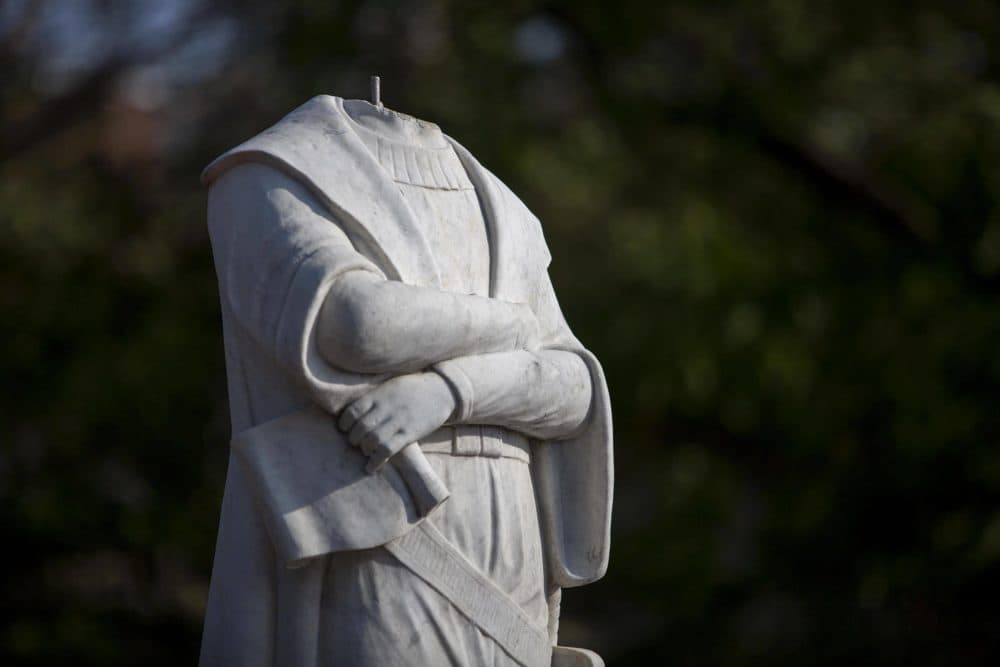Advertisement
Commentary
The Christopher Columbus Statue Should Stay. Here's Why

When I was 12, I asked my teacher a question that she couldn't answer.
We were on a class field trip to Georgia's infamous Stone Mountain, the state's most visited destination. It's less of a mountain than it is a massive dome that memorializes the Confederacy. Etched into its side are three Confederate soldiers, including Robert E. Lee and Stonewall Jackson. I couldn't understand, with what I learned about the Civil War and slavery, why there'd be an entire mountain dedicated to the Confederacy.
Many of the public memorials and statues in the South are in the image of Confederate figures. These sites are usually the first things vandalized or damaged during times of racial and political unrest. The North is different — there are no Confederate generals or soldiers to memorialize. Instead, colonial powers -- like Peter Faneuil and Christopher Columbus — are immortalized with statues, parks, streets and plazas.
Last Tuesday night, June 9, the Christopher Columbus statue in the North End's Christopher Columbus Waterfront Park was beheaded and vandalized with graffiti. Prior to this, on May 30, other statues and memorials in the Boston Common received similar treatment after the peaceful march to Boston's Statehouse dissolved into conflict between police and protestors.
By strict definition, public art is simply art that is in the public realm. In Boston, that art has looked a lot like the statue of Christopher Columbus or other bronze busts and sculptures of various historical figures. Luckily, we also have a dearth of colorful, more culturally representative public artwork like the massive mural project in Lynn and Nick Cave's Augment that actually engage with the communities the art is situated in.
...for many of us, these statues are not exemplary pieces of public art. They're embossed versions of the systems of oppression we live under.
It comes as no surprise that in the wake of protests across the country, sparked by the deaths of Breonna Taylor and George Floyd, that statues deifying Confederate and colonial leaders are being destroyed and toppled. I was tensely waiting for the Christopher Columbus statue to meet its fate. While some art historians and art lovers see these statues as valuable historic material, for many of us, these statues are not exemplary pieces of public art. They're embossed versions of the systems of oppression we live under.
Who was Christopher Columbus? There've been countless books, essays and talks about Columbus and the plague he and his men brought to the Americas, in both disease and genocide. Columbus is not a beacon of American fortitude, bravery or discovery. He is the patron saint of colonial violence.
After the beheading, Mayor Marty Walsh announced that the statue will be removed from the park. But removal of the statue, to store it away in some temperature-controlled basement or closet, is the easy way out. It allows Boston to avoid reckoning with what it means to be a city filled with statues of people who many communities see as diametrically opposed to our current moral standards. The beheaded statue, as it is, should stay.
Advertisement
Public art challenges, changes and shapes the way we see things. It can even dictate how we feel in public spaces. The beheaded statue of Christopher Columbus does this in a way the non-beheaded version never did. It does this in a way that removing the statue won't.
There is a distinct irony in removing a statue of Columbus when the park still memorializes his name and legacy. There is irony in removing his statue when black and brown children are still taught "In 1492, Columbus sailed the ocean blue" in school. There is irony in the fact that groups are still fighting to change the name of Faneuil Hall. There is irony in the fact that the Mashpee Wampanoag, Aquinnah Wampanoag and Nipmuc nations are still fighting for land sovereignty in this state.
Columbus is not a beacon of American fortitude, bravery or discovery. He is the patron saint of colonial violence.
Removal doesn't answer any questions nor does it undo any of the violence that's already been done. All it does is quell some of the unrest. All it is is a halfhearted attempt at placation.
If Boston were truly serious about engaging with history and its own racist and problematic past and present, the statue would be left where it is, without its head. Additional materials historically contextualizing the violence of Columbus should be added to the site. I think back to my youth, of asking my teacher why those men were etched onto the side of Stone Mountain. I imagine a child, with their parent or caretaker or teacher, walking past that statue of Columbus in that park and asking, "Why does it have no head?"
What answer will we give them? Will we explain that the "legacy" of Columbus, one the child has probably internalized through a school poem, really was no legacy at all? Will we explain why, across the country and globe, statues of colonial leaders are being toppled? Will we explain why there is still such a visceral reaction to the violence Columbus committed, a violence still acutely felt generations later?
I don't know if every parent or caretaker will be willing to answer those questions or be qualified to give fair and just answers. But what I do know is that without that statue, as it is now, the question of "why?" will never be asked.
Boston cannot performatively sweep its entanglements with its racism underneath the rug.
Leave the statue up. And let the real conversations begin.
